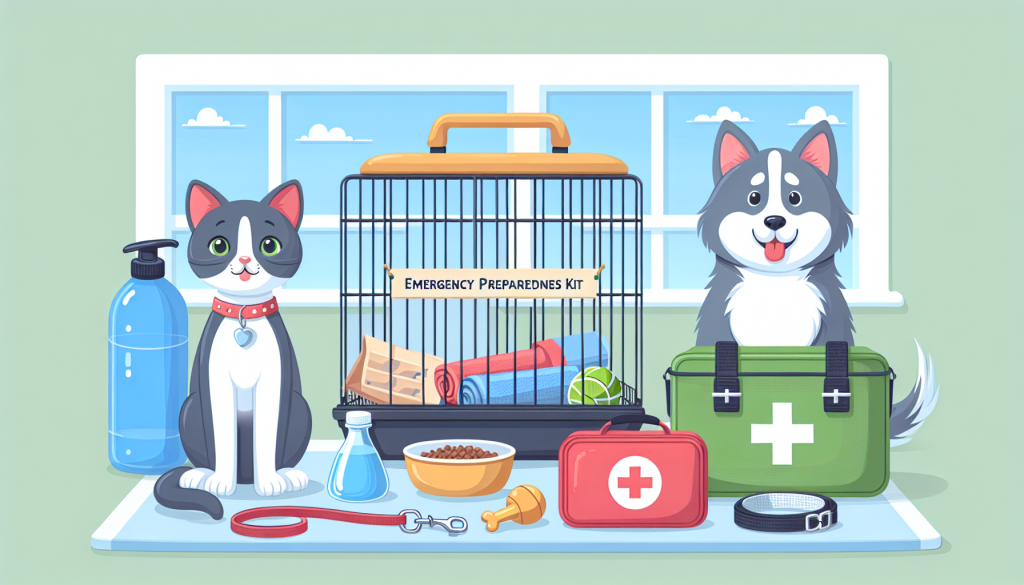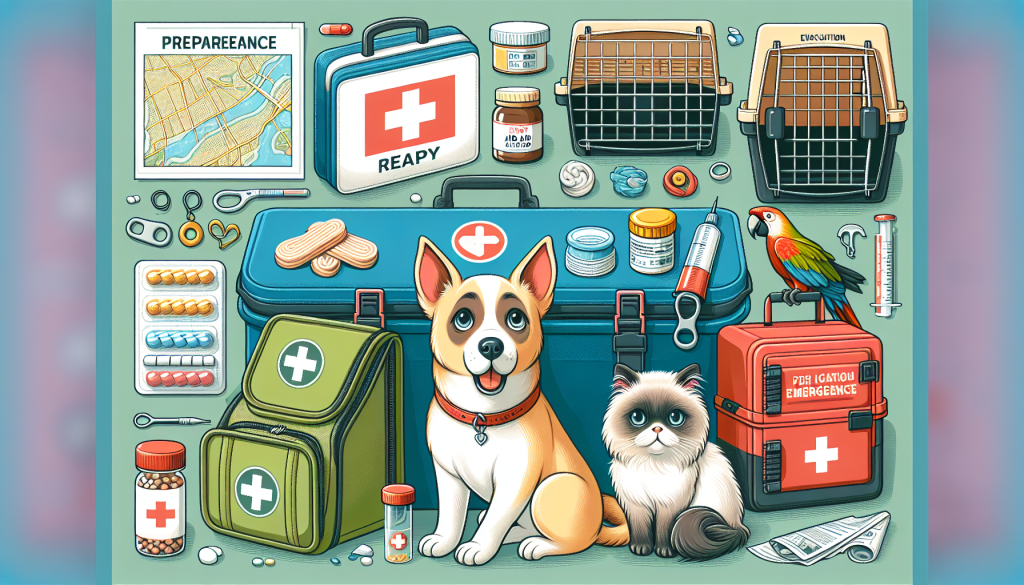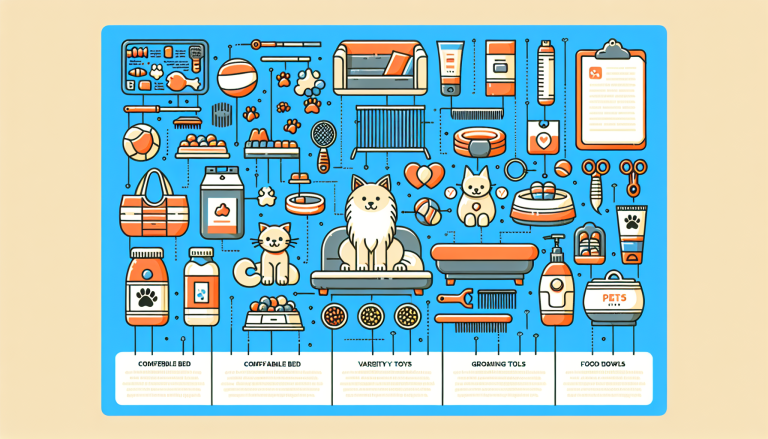In this article, you’ll learn how to create a pet emergency preparedness plan to ensure the safety and well-being of your beloved furry friend during unexpected situations. From natural disasters to medical emergencies, having a plan in place is crucial for any responsible pet owner. We’ll guide you through the essential steps to take, such as assembling a pet emergency kit, identifying safe zones in your home, and creating a communication plan. With these helpful tips, you can be prepared to protect your pet no matter what comes your way.

Table of Contents
Toggle1. Assessing Potential Risks
Identifying common emergencies
To create an effective pet emergency preparedness plan, it is important to first identify the common emergencies that your pet could potentially face. This might include natural disasters such as hurricanes, tornadoes, earthquakes, or floods, as well as man-made emergencies like house fires or gas leaks. By understanding the potential risks, you can better prepare for them and keep your pet safe.
Evaluating the specific risks for your pet
Every pet is unique, and it’s important to evaluate the specific risks that your furry friend might face. Consider factors such as your pet’s age, breed, and any pre-existing health conditions. For example, brachycephalic (short-nosed) breeds may have difficulty breathing in certain conditions, while senior pets might be more susceptible to heat stroke or hypothermia. Understanding these specific risks will help you tailor your emergency plan to meet your pet’s needs.
Researching local hazards and disasters
In addition to identifying common emergencies, it is crucial to research the local hazards and disasters that are specific to your area. This might include things like wildfires, blizzards, or even toxic plant species. By being aware of these local hazards, you can take proactive steps to prepare your pet and ensure their safety. Local emergency management organizations or animal control agencies can provide valuable information on the specific risks in your area.
2. Assembling an Emergency Kit
Essential supplies for your pet
When it comes to assembling an emergency kit for your pet, there are several essential items that you should include. These include:
- A sufficient supply of food and water for at least five days
- Food and water bowls
- A leash and collar with identification tags
- Extra harness or leash
- Basic grooming supplies
- Waste bags
- A sturdy crate or carrier for transportation
- Pet-specific medications and a first aid kit
Storing enough food and water
In an emergency situation, access to food and water may be limited. It is crucial to store enough food and clean water to sustain your pet for at least five days. Make sure to regularly check the expiration dates on your pet’s food and replace it as needed. Store the food in airtight containers to prevent spoilage and keep it easily accessible. Similarly, store enough water in clean, sealed containers and rotate it every few months to ensure freshness.
Including medications and medical records
If your pet requires any medications, it is essential to include them in your emergency kit. Make sure to regularly check the expiration dates on the medications and replace them as needed. Additionally, keep copies of your pet’s medical records, including vaccination history, allergies, and any pre-existing conditions, in a waterproof bag or folder. This will be invaluable in case of an emergency or if you need to seek medical care for your pet.
Adding comfort items
In times of stress and uncertainty, having familiar items can provide comfort to your pet. Consider adding a blanket or bedding with your pet’s scent on it, as well as their favorite toys or treats. These items can help reduce anxiety and provide a sense of security for your pet during an emergency situation.
3. Keeping Your Pet Secure
Creating a safe space
During an emergency, it’s important to have a designated safe space for your pet where they can feel secure. This could be a specific room in your house or a portable enclosure. Make sure the space is free from potential hazards and provides enough room for your pet to stand, lie down, and turn around comfortably. Place familiar items, such as bedding or toys, in the safe space to make it more comforting for your pet.
Maintaining up-to-date identification
Proper identification is crucial in case your pet gets lost during an emergency. Make sure your pet wears a collar with up-to-date identification tags that include your contact information. Consider microchipping your pet as an additional form of identification. Keep the microchip information updated with your current contact information in case you are separated from your pet during an emergency.
Using a pet carrier for easy transport
In situations where you may need to evacuate quickly, having a pet carrier can make transporting your pet much easier. Choose a carrier that is large enough for your pet to stand, turn around, and lie down in comfortably. Ensure the carrier is sturdy and has proper ventilation. Familiarize your pet with the carrier in advance by leaving it open and accessible in your home. This way, your pet will be more comfortable and less stressed when they need to be transported.
4. Developing an Evacuation Plan
Identifying pet-friendly shelters or hotels
In the event of an evacuation, not all shelters or hotels may accept pets. It’s important to research and identify pet-friendly shelters or hotels in your area, as well as along your evacuation routes. Contact these locations in advance to understand their pet policies, any fees involved, and whether they have any restrictions on the size or type of pets they accept. Having this information readily available will make it easier to find suitable accommodation for you and your pet during an emergency.
Arranging transportation in advance
When developing your evacuation plan, consider how you will transport your pet to safety. If you have a vehicle, make sure it is in good working condition and regularly serviced. Keep your vehicle’s gas tank at least half full at all times, as gas stations may be unavailable during emergencies. If you do not have a vehicle, research alternative transportation options in your area, such as local pet-friendly transportation services or arrangements with family, friends, or neighbors.
Mapping out primary and secondary evacuation routes
Having multiple evacuation routes is essential to ensure you can safely leave your home during an emergency. Identify primary and secondary evacuation routes and mark them on a map. Take into consideration any potential road closures, traffic congestion, or other obstacles that may affect your chosen routes. Practice driving these routes with your pet to familiarize yourself with the journey, especially if you need to take alternative routes.
Establishing a meetup location
In the event of an evacuation, it’s important to have a predetermined meetup location for you and your pet. This could be the home of a family member, a friend, or a designated pet-friendly shelter. Make sure all family members are aware of this location and have a plan to reunite with your pet if you become separated. Keep in mind that if you evacuate to a different area, local shelters and rescue organizations may be able to help facilitate reunification.
5. Preparing Emergency Contacts
Gathering contact information for veterinarians
Having the contact information for your regular veterinarian and any emergency veterinary clinics in your area is crucial in an emergency situation. Save these contact details in your phone, and also keep a printed list in your emergency kit. If you need to seek medical care for your pet during an emergency, having these contacts readily available will help you quickly connect with the appropriate veterinary professionals.
Organizing a list of pet-friendly neighbors or friends
Identify neighbors, friends, or family members who are willing and able to help care for your pet during an emergency. Make a list of their contact information, including their addresses and phone numbers. This way, if you are unable to care for your pet temporarily, you can easily reach out to your designated caregivers and ensure your pet is in safe hands.
Listing local animal shelters and rescue organizations
Research and compile a list of local animal shelters and rescue organizations in your area. These organizations may play a vital role in assisting pet owners during emergencies, providing temporary shelter, veterinary care, or other forms of support. Keep their contact information readily available in case you need to seek assistance for your pet.
6. Knowing First Aid for Pets
Learning basic pet first aid techniques
Having knowledge of basic pet first aid can be invaluable in an emergency situation. Consider taking a pet first aid and CPR class to learn essential skills such as performing CPR, addressing wounds, managing choking, and stabilizing fractures. These skills can help you provide immediate care to your pet until professional help is available.
Understanding common pet emergencies and their treatments
It’s also important to educate yourself about common pet emergencies and their appropriate treatments. Knowing how to recognize signs of distress, such as heat stroke, poisoning, or choking, can help you take prompt action when needed. Keep a pet first aid manual or guidebook in your emergency kit for quick reference during emergencies.
Attending a pet first aid and CPR class
To further enhance your knowledge and skills in pet first aid, consider attending a pet first aid and CPR class. These classes are often offered by local veterinary clinics, animal care organizations, or community centers. Not only will you gain valuable hands-on experience, but you’ll also have the opportunity to ask questions and clarify any doubts you may have.
7. Training and Socializing Your Pet
Teaching essential commands and obedience skills
Training your pet in essential commands and obedience skills can greatly contribute to their safety during emergencies. Make sure your pet knows basic commands such as “sit,” “stay,” and “come.” This will enable you to better control your pet’s behavior in potentially dangerous situations. Consistency, positive reinforcement, and patience are key when training your pet.
Socializing your pet with unfamiliar people and animals
During emergencies, your pet may come into contact with unfamiliar people, animals, or environments. Proper socialization can help your pet remain calm and less anxious in these situations. Gradually expose your pet to new experiences, people, and animals in a controlled and positive manner. This will help them develop the necessary confidence and adaptability to navigate unfamiliar circumstances.
Desensitizing your pet to loud noises and crowded environments
Loud noises and crowded environments are common during emergencies. Desensitizing your pet to such stimuli can help reduce their anxiety and fear. Start by exposing your pet to recorded or simulated sounds, gradually increasing their volume over time. Similarly, gradually introduce your pet to crowded spaces or unfamiliar environments, rewarding them for calm behavior. This gradual exposure will help your pet become more resilient and less reactive during emergencies.
8. Creating a Pet Care Binder
Documenting your pet’s medical history and vaccination records
Creating a pet care binder is an organized and comprehensive way to keep all your pet’s important information in one place. Include copies of your pet’s medical records, including vaccinations, surgeries, and any ongoing treatments. This will help ensure that you have accurate and up-to-date information readily available in case of an emergency, or if you need to temporarily entrust your pet’s care to someone else.
Keeping copies of important documents
In addition to medical records, make copies of other important documents such as adoption papers, ownership certificates, and proof of microchip registration. These documents can help prove ownership and provide crucial information about your pet’s background or special needs. Keep the copies in your pet care binder, ensuring they are easily accessible when needed.
Including a recent photo for identification purposes
Include a recent photo of your pet in your pet care binder. This will serve as a visual reference in case you need to create missing pet posters or provide identification to search and rescue personnel. Make sure the photo clearly shows any unique markings or characteristics that can help distinguish your pet from others.
9. Communicating Your Plan
Discussing the plan with family members and neighbors
An effective pet emergency preparedness plan requires clear communication within your household. Sit down with your family members and discuss the plan in detail. Make sure everyone knows their roles and responsibilities, including who will be in charge of evacuating and caring for the pet. Additionally, consider informing your neighbors about your plan, as they may be able to help in case of an emergency.
Appointing a responsible person as a designated caregiver
In the event that you are unable to care for your pet during an emergency, it is essential to have a designated caregiver who can step in and provide the necessary care. This person should be responsible and trustworthy, familiar with your pet’s needs, and willing to take on the responsibility. Make sure this person is aware of their role and has access to your pet care binder and emergency kit.
Informing emergency responders about your pets
When communicating your plan with emergency responders, it’s important to inform them about the presence and location of your pets. Provide clear instructions on how to access your pets, any specific care instructions, and the contact information of your designated caregiver. This will help ensure that emergency responders are able to provide appropriate assistance and support to both you and your pets.
10. Regularly Reviewing and Updating Your Plan
Setting a schedule for plan review and maintenance
Creating a pet emergency preparedness plan is not a one-time task. It is crucial to regularly review and update your plan to ensure its effectiveness. Set a schedule, such as annually or biannually, to review your plan and make any necessary adjustments. This will help keep your plan current and ensure that you are well-prepared for any potential emergencies.
Updating contact information and phone numbers
As time goes on, contact information and phone numbers may change. Regularly check and update the contact information in your pet care binder, including your veterinarian’s contact details, designated caregiver’s information, and emergency shelters or rescue organizations. This will help ensure that you can reach the necessary individuals or organizations when needed.
Checking expiration dates of supplies and medications
Lastly, regularly check the expiration dates of the supplies and medications in your emergency kit. Replace any expired items promptly to ensure that your kit is fully stocked and ready to go in case of an emergency. It is also a good idea to periodically check the functionality of any equipment, such as flashlights or batteries, to ensure they are in working order.
By following these comprehensive steps, you can create a pet emergency preparedness plan that will help keep your furry friend safe during any unexpected situation. Remember to regularly review and update your plan to ensure its effectiveness, and always prioritize the well-being of your beloved pet.







